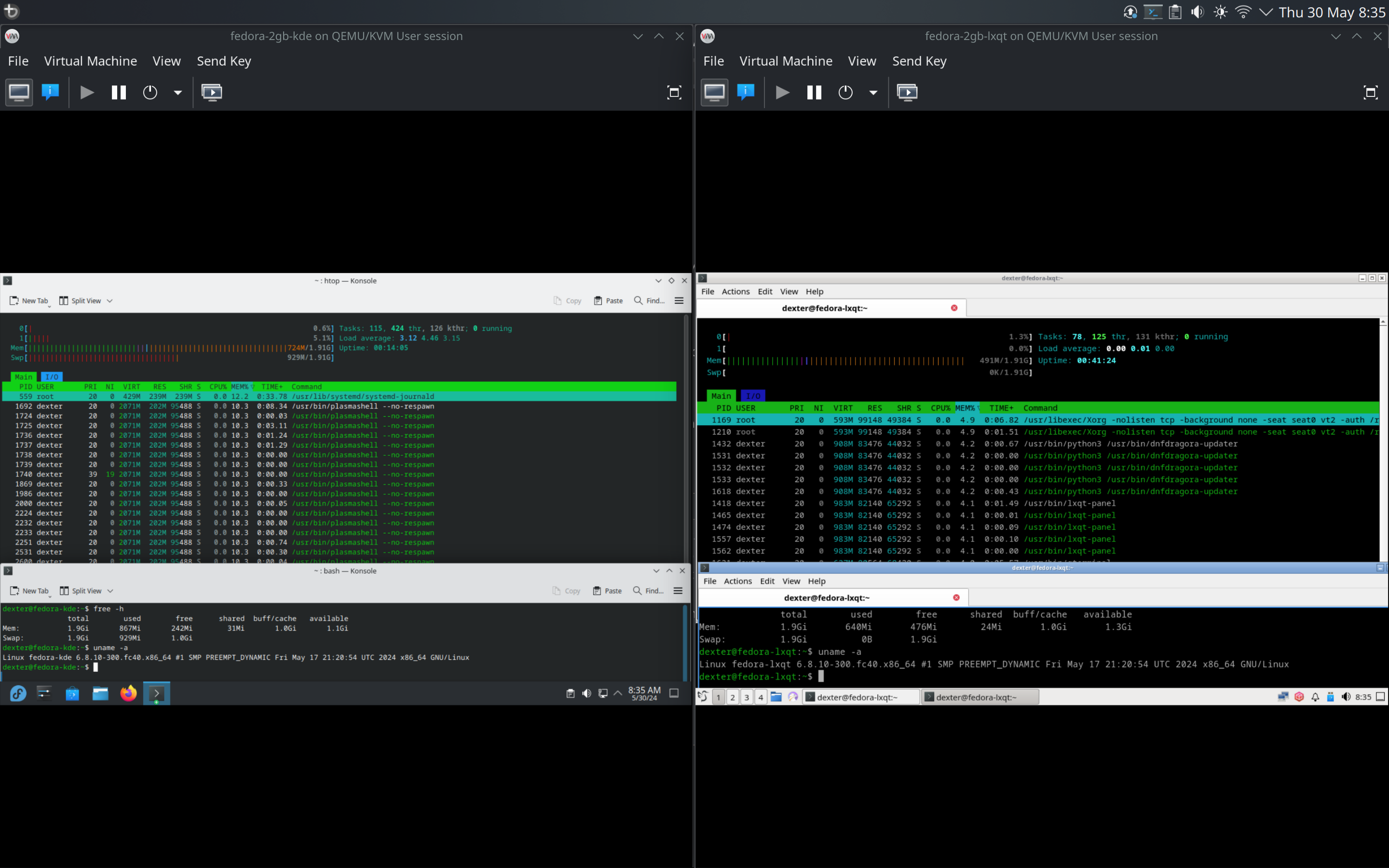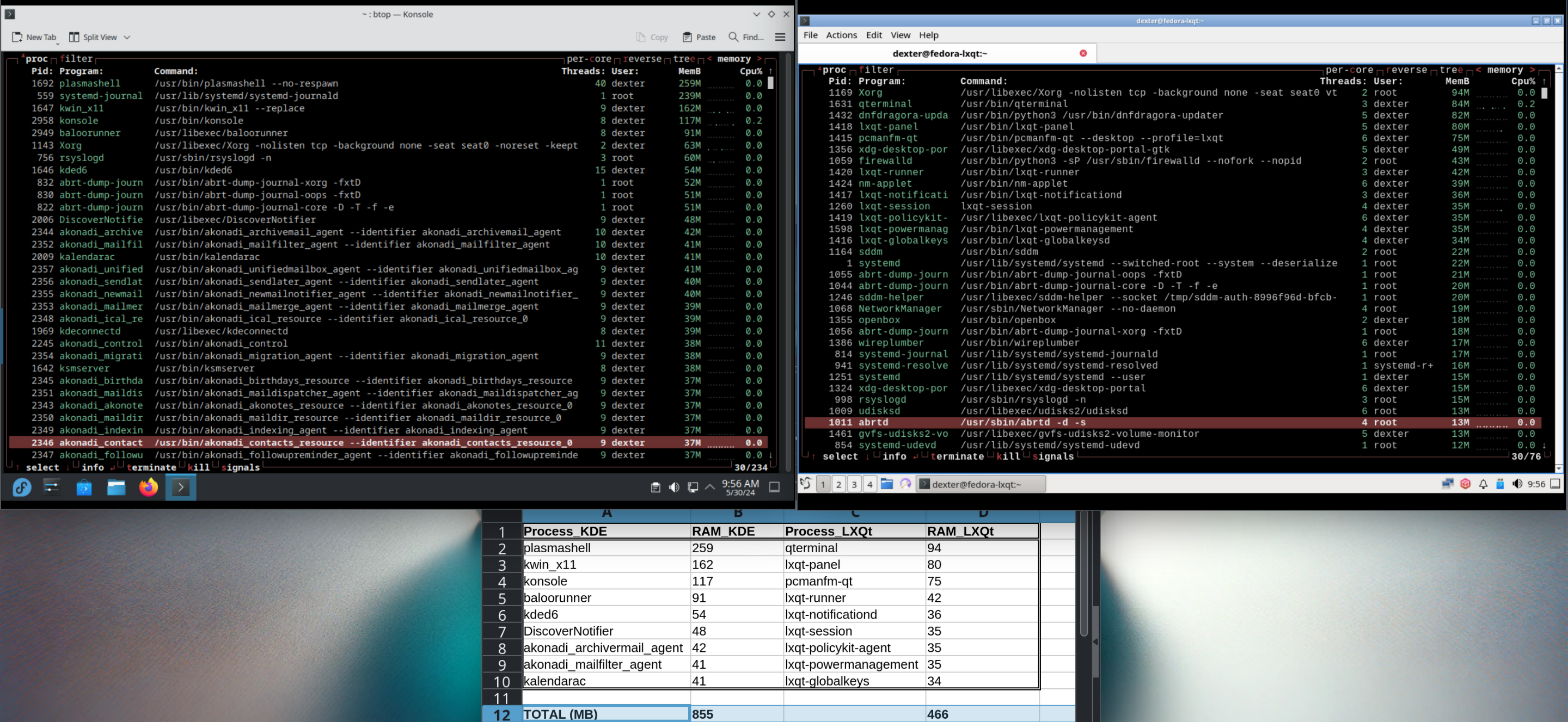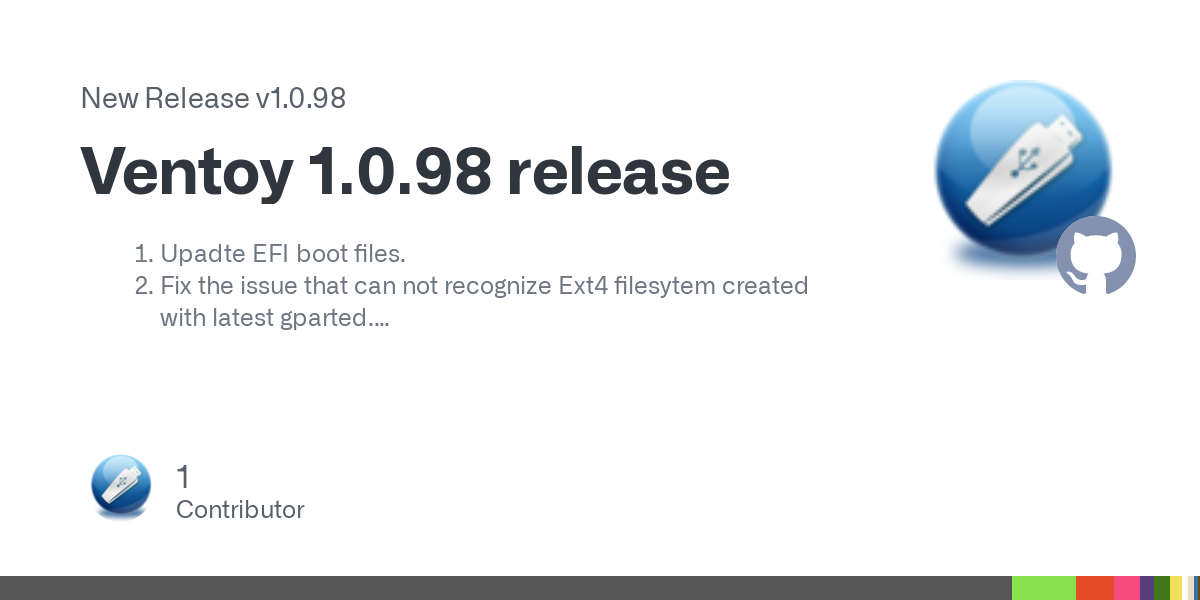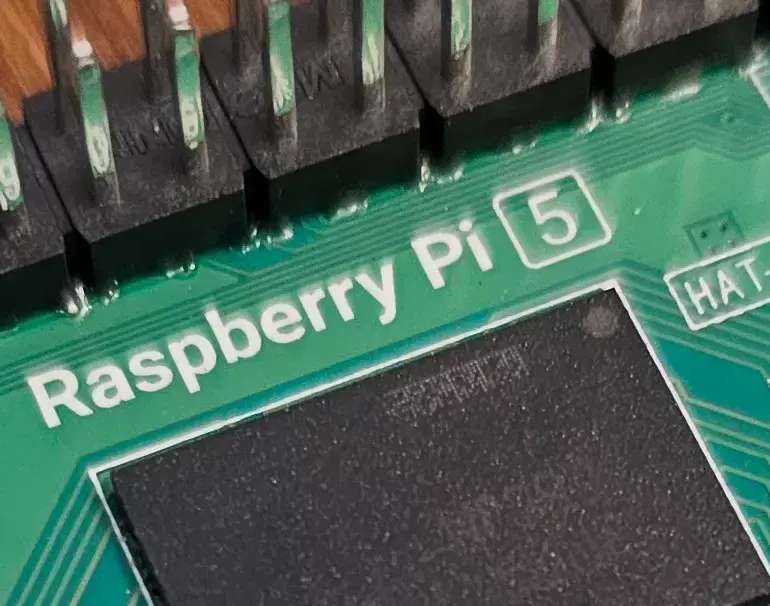- 17 Posts
- 291 Comments
You’re arguing semantics and that’s not the point I’m trying to argue here. Forget the term “Plasma”. I don’t really care about what the DE is branded as or what’s in “Plasma” the software package. When I say “KDE”, I mean the desktop + all the basic default/recommended apps that you’d see on a typical KDE installation, such as Dolphin, Konsole, Kate, Kalculator, Spectacle etc that’s part of the KDE project. IDK whether the apps I’ve mentioned are considered part of “Plasma” or not, but again, that’s not the point, I’m saying this is what I meant when I said “KDE” - and what most people would expect when they picture a “KDE” environment.
Anyways, I tested this myself on two identical VMs with 2GB RAM, one installed with Fedora 40 KDE, and another with Fedora 40 LXQt, both set to use X11 (because LXQt isn’t Wayland ready yet), both updated and running the latest kernel 6.8.10-300.fc40. I logged into the DEs, opened only two terminal windows and nothing else, ran, and ran
htop. The screenshot speaks for itself:
And when I tried disabling swap on both machines, the KDE machine was practically unusable, with only 53MB RAM remaining before it completely froze on me. Meanwhile, the LXQt one was still very much usable even without swap enabled.
I’d like to see you try running without swap and see how it fares. And if you think it’s unfair disabling swap on a 2GB machine - try installing LXQt yourself, disable swap and see for yourself how much more usable it is compared to KDE.
And this is why I say KDE is bloated and not suitable for old machines.
Edit: Also, check out the memory consumption listed by a user in this post: https://lemmy.nz/comment/9070317
Edit2: Here’s a screenshot of the top 30 processes on my test systems, side-by-side:

Of the above, I calculated the usage of the top 10 processes specific to each respective DE, and you can see that KDE’s memory usage is almost double that of LXQt. Had I counted all the DE-specific processes, it’d no doubt be a lot more than double.
Correct me if I’m wrong, but this #OptGreen project isn’t talking specifically about Plasma, is it? They don’t mention Plasma anywhere on the page they linked.
In any case, that’s irrelevant, also, I don’t doubt that KDE can’t run at all under the specs you mentioned - that’s not the issue. The question is, how much free/usable RAM do you actually have on that machine - let’s say with no apps open first, and with then check again with Konsole + Dolphin + KWrite/Kate open? And for fun, fire up Konqueror as well and check again.
Edit: Screenshots proving that what you’re saying is not correct:


I’m not talking specifically about Plasma, I’m talking about the “DE” part of KDE in general; and particularly in this context of repurposing and extending the life of old PCs.
I find it a bit ironic for KDE to be pushing this message, when it’s a heavy DE (relatively speaking) - it’s NOT what anyone would have in mind when when selecting a DE for an old PC.
For instance, take LXQt - run the default/recommended file browser, terminal and text editor, and compare it with KDE + equivalents - you’d see a significant difference in resource consumption. On a system with low RAM, that extra bit of free memory makes a big difference, as it could mean avoiding the penalty hit of the swap file, which you’d invariably run into as soon as you fire up a modern Web browser. So it’s vital that the DE use as little resources as possible on such a machine.
So, are there any plans to reduce the bloat in KDE, maybe even make a lightweight version (like LXQt) that’s suitable for older PCs with limited resources?

 9·2 months ago
9·2 months agoYou should still have the previous package in your cache right? If so, extract that and the current package, and then compare the two folders to see what’s changed -
meldis a good tool for that.

 6·2 months ago
6·2 months agoSounds like an issue with your WiFi adapter/driver. You can verify this by creating a mobile hotspot on your phone and connecting your PC to it and see if you get the same issue, if you do then it proves it’s got nothing to do with your router.
Another thing you can check is your journalctl logs - run
journalctl -fbefore launching the game, then run the game and quit it when you run into the DNS issue, and check the logs at the time the issue occurred. If there’s indeed a hardware/driver issue, the errors should show up in the logs.If it’s a driver issue, there may not be much you can do about it besides reporting the bug and implementing some sort of workaround (eg using a VPN). Of course, depending on the error, there may be a fix you can apply, like turning of aspm for your chip. A better option would be to replace the WiFi chip/adapter you’re using and get something that’s better supported under Linux, like something with an Intel or Atheros chip. But check journalctl first and see how it goes from there.

 52·2 months ago
52·2 months agoIn the footnotes they mention GPT-3.5. Their argument for not testing 4 was because it was paid, and so most users would be using 3.5 - which is already factually incorrect now because the new GPT-4o (which they don’t even mention) is now free. Finally, they didn’t mention GPT-4 Turbo either, which is even better at coding compared to 4.

 61·2 months ago
61·2 months agoI wouldn’t recommend it in your case. Mind you, Arch is easy enough to install with the archinstall script or say using EndeavourOS, but the issues come afterwards. For starters, you’ll need to occasionally deal with .pacsave/.pacnew files when you do an update, keep up with Arch news and be aware of breaking changes which may require some non-trivial manual intervention, like in this post for example: https://lemmy.nz/post/7648427
So if you’re after something that “just works”, then Arch isn’t for you. Since you’re into gaming and you’re lazy, Bazzite would be an excellent choice as its an immutable OS with atomic updates (updates either work or don’t, there’s no middle/broken state). But if you’re after a more traditional distro (ie, non-immutable), Nobara or Pop!_OS also work well for gaming.
You’ll need to bind a hotkey to a third-party tool such as ydotool.
Eg using ydotool, the command would be
ydotool click 0xC1

 29·2 months ago
29·2 months agoI’ve heard of Intel Arc users for instance not able to play certain games because it checks for AMD/nVidia, so you’d have to fake the GPU vendor to get it to work.
Eg see stuff like this: https://www.phoronix.com/news/Intel-Graphics-Hogwarts-Legacy
Or https://www.phoronix.com/news/The-Finals-Intel-Arc-Graphics

 57·2 months ago
57·2 months agoBefore y’all get excited, the press release doesn’t actually mention the term “open source” anywhere.
Winamp will open up its code for the player used on Windows, enabling the entire community to participate in its development. This is an invitation to global collaboration, where developers worldwide can contribute their expertise, ideas, and passion to help this iconic software evolve.
This, to me, reads like it’s going to be a “source available” model, perhaps released under some sort of a Contributor License Agreement (CLA). So, best to hold off any celebrations until we see the actual license.

 11·2 months ago
11·2 months agoYou cannot go back after trying it
I did! Used to have a Samsung 49" ultrawide. After using it for a couple of years, I sold it and got a 16:10 32" QHD, which I found worked better for me (+ one or two laptop screens for chat / random stuff when I’m doing serious work).
The biggest issue I had with the ultrawide is that most of the games that I played weren’t optimised for it, especially in some games where things like the mini-map might be at the far end of the screen, or worse, if it was an older game then you’d have to put up with black bars, or play the game in windowed mode.
I don’t play D4 anymore so I can’t say if this still works, but back when I did, I used to launch it (ie the Battle.net launcher) from Steam, as a non-Steam game.
I also used the latest Proton-GE as the compatibility tool, so that’s something you could try as well.
For #4, you could use WinApps - just pair it with a debloated version of Windows (like Tiny11) and you won’t even notice any performance impact. I made a custom build of Tiny11 core and it’s idle RAM usage is just 605 MB, and CPU usage close to 0%. When I launch a .docx on Linux, it loads up Word as a RemoteApp in less than a second and it sorta feels like a native app. It’s all pretty seamless once you get it going.
If you are going down this route btw, I highly recommend using freeRDP v3 (which you can install from the AUR), since it’s got a ton of improvements over the old 2.x versions.

 2·2 months ago
2·2 months agoThis is a general tech community, mostly centered around news and end-user technology discussions, so it’s very unlikely you’ll get an answer here. Might want to try asking on Reddit or some dedicated Datto/Connectwise forum.
Well I haven’t used Plasma Mobile or any of the apps you’ve mentioned, so it’d be nice to see what it all looks like! (and I don’t have a device I can try it on either, unless I can get it working with Termux + Termux-X11?)
Nice writeup, but it would’ve been nice if you added some screenshots or a short video of your setup!
Nice, great to see the continued development of an old-school, lightweight browser. We need more active alternatives to the bloated duopoly.
















I’m not moving any goalposts. You’re the one arguing about the semantics around “Plasma”, and I keep saying that’s irrelevant.
Refer back to my original comment which was, and I quote:
To clarify, here I was:
The ENTIRE point of my argument was the KDE isn’t really ideal RELATIVELY, for older PCs with limited resources, and I’m using LXQt here are a reference.
In a subsequent test, here’s a direct apples-to-apples(ish) component comparison:
plasmashellwas sitting at 250MB btw in this instance btw.The numbers speak for themselves - no one in their right minds would consider KDE (or
plasmashell, since you want to be pedantic) to be “light”, in RELATION to an older PC with limited resources - which btw, was the premise of my entire argument. Of course KDE orplasmashellmight be considered “light” on a modern system, but not an old PC with 2GB RAM. Whether something is considered light or bloated is always relative, and in this instance, it’s obvious to anyone that KDE/plasmashellisn’t “light”.